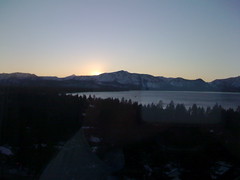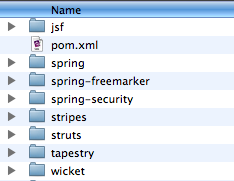The State of the Web 2009
This afternoon, I attended The State of the Web 2009 at Web Directions North. Below are my notes from this session.
This panel has quite the list of superstars:
- Chris Wilson (Microsoft)
- Dan Connolly (W3C HTML Working Group)
- Mike (TM) Smith (W3C HTML Working Group)
- Lars Erik Bolstad (Opera)
- Scott Fegette (Adobe)
- John Allsopp (Organizer and Style Master Developer)
John is moderating this session and is starting by asking each panelist to speak about what they believe the state of the web is.
Chris Wilson
The future of the web may be as ubiquitous as electricity. Chris has a desktop, two laptops (one 10" NetBook, one is a 13" MacBook) and an iPhone. There's a lot of difference between these devices, especially when it comes to screen size. Chris uses a number of different browsers throughout the day. The web isn't just one browser, it isn't just one platform. He's showing a slide with a browser market share graph from http://www.netapplications.com.
Many different browsers are a reality. Many different devices are a reality. Web builders need to learn to write scalable applications that run across multiple browsers, devices and environments. They need to use progressive functionality and learn the tools they have in CSS and HTML. Semantic structuring helps.
Developers need to learn to live with multiple browsers. Cross-browser interoperability will get better, but it's likely to be an issue forever. Test suites with new specifications are helping. Developers should build for browsers of today and tomorrow.
You should build the applications you want to build and then figure out how how to make them degrade gracefully on the web.
Lars Erik Bolstad
Opera Software has 600 employees in 10 countries. They've been developing Opera and other browsers since 1995. The bulk of what Opera does is based on commercial browser deliveries to OEMs around the world.
Devices, platforms and networks: they come in all shapes and sizes. Only one thing unifies them: The Web. The browser is becoming more and more important on these devices. Users are not satisfied with WAP-based content anymore, they want the same content no matter which device they're using.
Opera Mini does its processing on the server-side. This allows Opera to gather statistics. These stats show that users around the world hit the same top sites on their mobile devices as they do on their desktops. It's a one-to-one match. Opera is seeing tremendous growth in the usage of Opera Mini, both in developed countries and emerging markets.
The point: don't just develop for desktop browsers. The mobile market seems to be growing much faster. The problem is actually more in the hands of browser developers since they have to satisfy the user's desire to see the same content on mobile vs. desktop.
Opera is focusing on advancing core browser technology in three areas:
- Web standards: CSS (webfonts, backgrounds/borders, transitions, transforms), HTML 5 (video/audio, persistent storage, drag and drop) and W3C Geolocation API and "Mobile DOM" API (access to camera, address book, calendars).
- Performance: VEGA (vector graphics-based rendering, hardware acceleration) and CARAKAN (new JavaScript engine, native compilation). For more details, see http://my.opera.com/core.
- Web applications: Standalone web apps, RIAs, Widgets. Gears support and Developer Tools.
Dan Connolly
The web is kinda important these days. It's a big deal. Make a mistake and 300 million dollars go away (see end of last entry about United news). One of the beauties of the web is you can easily participate as an individual. You can report bugs, write articles and be a part of many web standards groups. Most of the other systems in the world don't provide this kind of access.
Dan has been under a rock for the last 5 years working on Semantic Web stuff. Now that he's back in the game, it's incredible how much stuff is going on. He's glad there's JavaScript frameworks so he doesn't have to learn everything. The default security policies in browsers are a little rickety at this point. They allow you to download and run JavaScript from virtually any site. Caja might help to solve this. Dan believes that security will become more important and stricter to protect web users.
Scott Fegette
Scott is a Product Manager in the Web Group of Adobe. At the beginning of each year, they do heavy user research. Adobe wants people that develop content for the web to be as expressive as possible. Scott is going to give us a peak into the conversations he's had with the web community.
One of the biggest topics on people's minds is The Economy, but it's not negative as you might think. Small web designers are actually getting more business in the downturn, likely because companies are polishing their presence on the web. People are working much more distributed these days. There's a few areas that Adobe generally asks about: CSS, JavaScript, HTML (both statically and dynamically).
Frameworks are becoming more important to developers, as well as with clients. They've even seen some clients demand certain frameworks. Two years ago, when Adobe talked to small design shops and agencies, most web sites were built statically. Now they're developing with frameworks like WordPress. Out of 60 folks they talked to, only 2 were using static systems and not CMSes.
In the JavaScript frameworks arena, jQuery is the dominant leader. Shops are starting to use CSS frameworks as well. The only one Scott mentioned was Reset. Design is becoming a technical discipline and Adobe is calling this Stateful Design. WYSIWIG is definitely dying and designers aren't developing with visual tools.
The kind of projects that people are working on has changed a lot. Many shops are being asked to do work on mobile development. The iPhone has done wonders for the industry in raising the awareness of what a mobile device can do.
The other big investments for Adobe is RIAs and AIR. Ajax has matured enough that it can now compete with proprietary plugins like Flash. The reason for AIR is to allow web developers to use their skills to develop desktop applications. Flash and Flex are often overkill for browser-based applications, but they do often handle video and audio better than Ajax applications.
Mike (TM) Smith
Mike is also known as the "W3C HTML jackass". Mike thinks the state of the web is that it's a mess in a lot of ways. If you don't believe him, ask Doug Crockford. Most of this stuff is going to remain a mess for the next 20 years, unless another genius like Tim Berners-Lee comes along and invents something new. However, the good part about it being a mess is that we all have jobs.
One of the biggest things they're trying to do with HTML 5 is not breaking backward compatibility. Other working groups at the W3C don't share this philosophy, hence the reason they don't have browser vendors participating. Many of the ideas for HTML 5 game from Gears and Ajax Framework developers like John Resig. All this will make things less messy, especially with the help of browser vendors.
Developers like the ubiquitous web and are pushing the mobile web. Mike thinks everyone just needs to get a life (big applause). For mobile, SVG has already been a big success. You will see significant great things with SVN happen in major browsers by next fall. If you're a web developer, you should spend some time experiment with SVG. It will payoff for you. If it doesn't pay off for you and you see Mike next year at Web Directions North, you can punch him in the face.
Location-aware applications will be big as well. Browser vendors are implementing the Geo Location API. It's implemented in Opera, Firefox, WebKit and Gears. Video on the web will be significant as well. The SVG working group pioneered video support into standards, before HTML 5. Many of the problems they face are related to video codecs. The only way to solve the problems with video on the web is with money and lawyers. Very specifically, there's no royalty-free codec for video. This is nothing that standards bodies can solve. The most promising is that Sun Microsystems is developing an open codec and spending money to make sure they're not infringing on patents.
Not only is the HTML Working Group improving markup in HTML, they're also working on coming up with new APIs that give you access to features. If you have ideas that aren't included in HTML 5, the group is definitely interested in hearing about them.
After each panelist talked, John asked them questions about what's the biggest thing they'd like to see implemented by everyone (open video codec, geo location api were the winners). Mike also did some complaining about XML and how broken it is because there's no failure mechanism. There was some audience banter with Chris about SVG in IE.
Conclusion
This was a very interesting session, especially to hear from the people who are building/supporting the future of the web. I liked Scott's talk on what Adobe's hearing from their users. I also liked hearing Mike (TM)'s opinionated thoughts on XML and his non-marketing approach to most everything related to the web. Lars from Opera had a marketing-ish presentation, but it was nevertheless interesting to hear what Opera's working on. Good stuff.


























